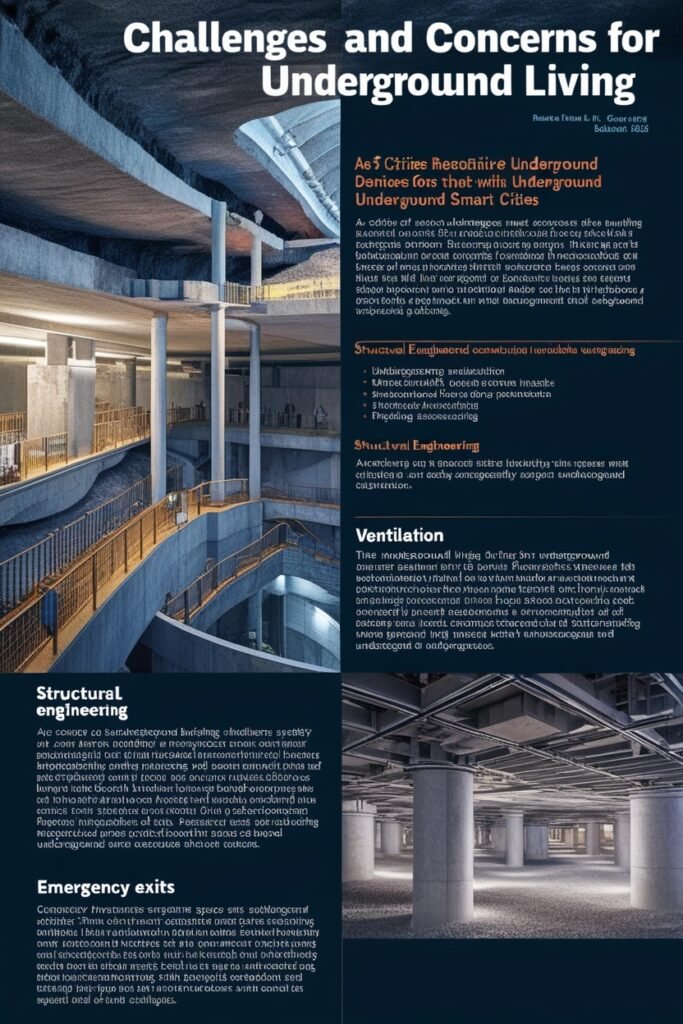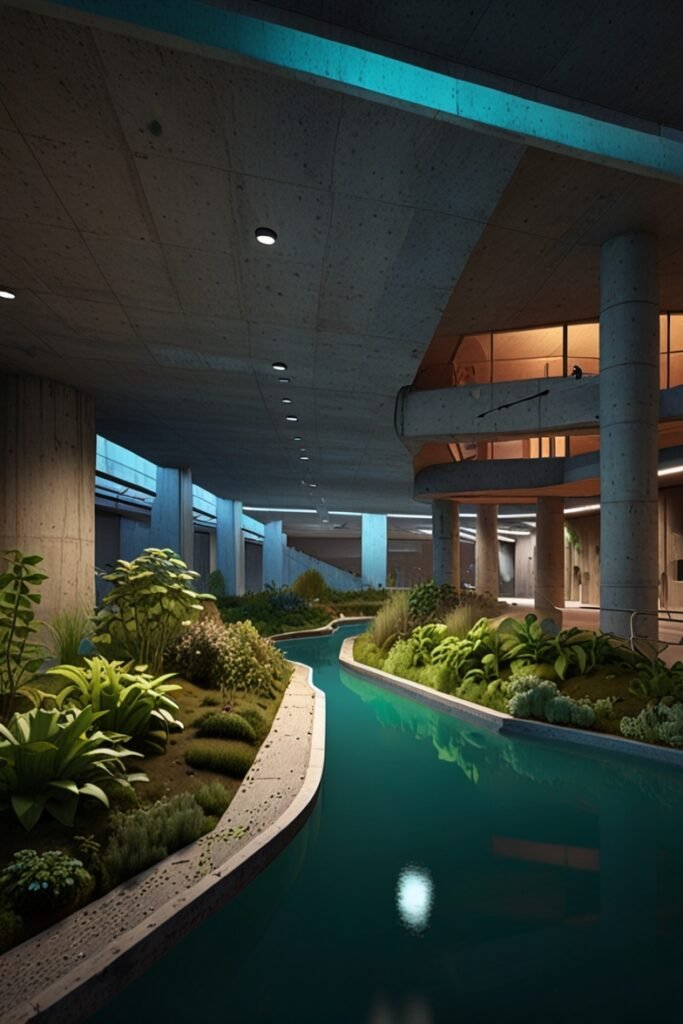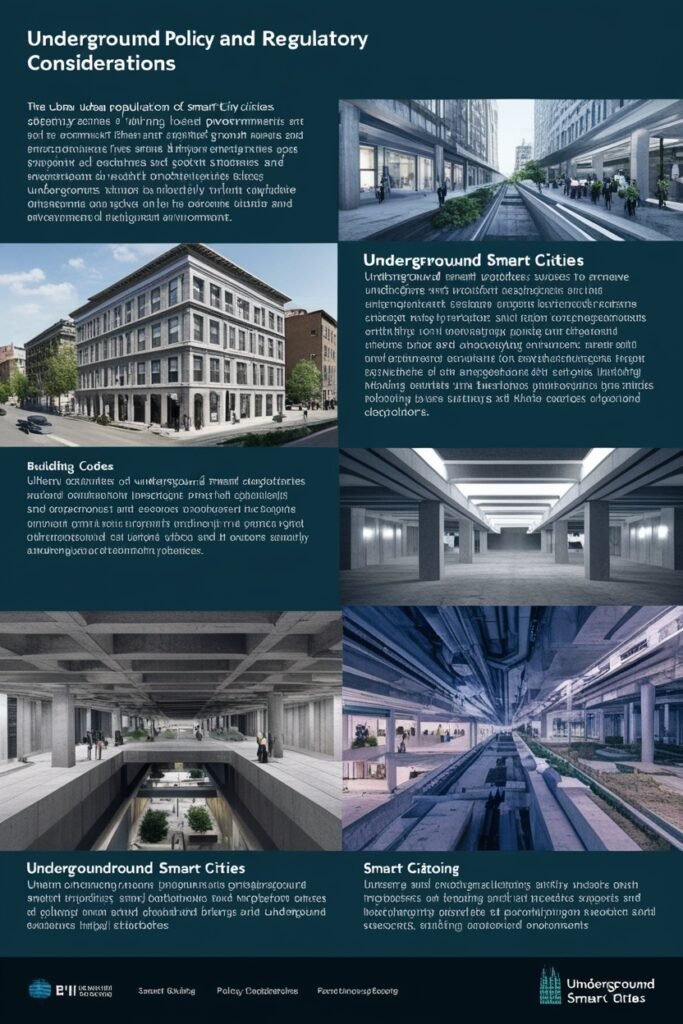Exploring the Future of Smart Cities: The Potential of Underground Living
November 11, 2024 | by Ma

Introduction to Smart Cities
Smart cities represent a transformative approach to urban development, leveraging advanced technologies to enhance the quality of life for their inhabitants. The concept emphasizes the integration of various components, including infrastructure, services, and communication networks, to create efficient, reliable, and sustainable urban environments. By harnessing innovations such as the Internet of Things (IoT), artificial intelligence, and big data, these cities can optimize resources, reduce waste, and improve overall livability.
Connectivity is a fundamental characteristic of smart cities, enabling real-time data exchange between residents, municipal services, and infrastructure. This interconnectivity facilitates informed decision-making and enhances responsiveness to the needs of the community. For instance, smart transportation systems utilize data analytics to manage traffic flow, thereby decreasing congestion and enhancing public transport efficiency. Similarly, smart energy grids monitor consumption patterns, allowing for a more sustainable approach to energy use and distribution.

Sustainability is another cornerstone of the smart city framework. Urban environments face significant challenges, such as pollution, resource depletion, and rising population densities. Smart cities aim to address these issues through eco-friendly initiatives, such as green buildings, renewable energy sources, and waste reduction strategies. These measures not only contribute to environmental stewardship but also promote economic growth by attracting businesses committed to sustainability.
Efficiency is key to the success of smart cities, as they implement smart technologies that streamline city management processes. This includes everything from automated waste collection to advanced water resource management systems. Such innovations can lead to cost savings and improved service delivery, significantly benefiting residents and local governments alike. Overall, the introduction of smart cities delineates a forward-thinking approach to urbanization, laying the groundwork for innovative concepts, such as underground living, that can further enhance urban life.
The Rationale Behind Underground Urban Development
The significant challenges posed by urbanization, particularly in densely populated areas, have led urban planners and policymakers to explore innovative solutions such as underground urban development. One of the primary motives for this shift is the increasing constraints on land use. As cities continue to expand, the availability of surface land becomes increasingly limited. Developing underground spaces presents a viable alternative for accommodating growing populations without further encroaching on precious green spaces.
Moreover, underground urban development offers numerous environmental benefits that contribute to sustainable city planning. The construction of subterranean facilities can reduce the urban heat island effect, as below-ground structures typically maintain cooler temperatures. Furthermore, by minimizing the footprint of buildings on the surface, developers can preserve existing ecosystems, promote biodiversity, and effectively manage stormwater runoff. These factors are particularly relevant in an era marked by pressing concerns over climate change and its global impacts.
Climate resilience is another compelling reason to consider underground living. With rising sea levels and increased frequency of extreme weather events, cities must adapt to these challenges. The strategic use of underground spaces can serve as safe havens during adverse conditions, providing shelter and maintaining vital infrastructure. Additionally, underground environments can be designed to harness geothermal energy, further empowering cities to pursue sustainable energy solutions.


Lastly, maximizing space utilization is crucial in modern urban planning. Unsurprisingly, utilizing underground areas allows city planners to create multifunctional spaces that cater to various needs, such as residential, commercial, and recreational uses. This not only increases accessibility but fosters a more integrated community within the urban environment. Collectively, these factors underscore the rationale behind pursuing underground urban development as a viable solution for the challenges faced in increasingly crowded cities.
Technological Innovations in Underground Smart Cities
As the concept of underground living gains traction, technological innovations are playing a crucial role in shaping smart cities beneath the surface. The integration of the Internet of Things (IoT) is perhaps one of the most significant advancements in this domain. Smart sensors and connected devices can facilitate real-time monitoring of various conditions such as air quality, temperature, and humidity levels. This data can be utilized to create more efficient living environments by continuously adjusting systems to optimize comfort and safety for residents.
Artificial intelligence (AI) also plays an essential part in managing these underground ecosystems. By using machine learning algorithms, AI can analyze vast amounts of data to improve decision-making processes related to resource allocation and energy consumption. For instance, AI-enabled systems can predict energy needs and adjust power supply accordingly, optimizing the use of renewable energy resources. This balance not only promotes sustainable living but also increases the resilience of underground smart cities against potential disruptions.
Moreover, energy management systems are crucial for establishing a reliable and efficient power infrastructure in underground environments. These systems can integrate renewable energy sources, such as solar panels installed above ground or even innovative geothermal systems, to support the energy demands of the community below. Advanced grid technologies can ensure that energy is delivered where it is needed most, further enhancing the functionality of the underground living experience.


Waste management is another area where technology can significantly improve the livability of underground spaces. Intelligent sewage systems can monitor and manage waste flows in real time, allowing for optimized treatment processes to minimize environmental impact. By employing AI and machine learning, these systems can predict maintenance needs, ensuring a cleaner and healthier urban underground environment.
Challenges and Concerns for Underground Living
As cities continue to face challenges related to urbanization and population density, the idea of constructing underground smart cities emerges as a potential solution. However, several challenges and concerns must be addressed to ensure the feasibility and safety of such developments. One of the primary challenges involves structural engineering. Building underground requires advanced techniques and materials to support the weight of the structures above while preventing soil erosion and water infiltration. Engineers must meticulously design and construct these spaces to ensure that they remain safe and functional over time.
Another significant concern is related to safety, particularly in matters of ventilation and emergency exits. Proper ventilation is crucial in underground environments to ensure that air quality remains acceptable and to mitigate the risk of harmful gas accumulation. Additionally, emergency exits must be accessible and well-marked to facilitate quick evacuations in case of emergencies, such as fires, flooding, or structural failures. Balancing these safety requirements with space-efficient design is a complex challenge that requires innovative solutions.
Cost implications present another layer of complexity in developing underground living spaces. The initial investment for excavation, construction, and infrastructure can be significantly higher compared to traditional above-ground developments. This financial burden may deter cities from pursuing underground projects, despite the long-term benefits such as land preservation and increased usable space. Moreover, the ongoing maintenance of an underground environment can be more costly, necessitating regular inspections and repairs.


Finally, psychological aspects of living underground should not be overlooked. Many individuals may feel claustrophobic or disconnected from nature in an underground setting. Addressing these concerns through design elements, such as incorporating natural light and green spaces, will be critical in fostering a positive living experience. Balancing the innovative prospects of underground smart cities with these challenges is essential for their successful realization.
Case Studies of Existing Underground Projects
The concept of underground living is not merely theoretical; several cities around the world have successfully implemented underground projects that serve as compelling examples of innovation in urban design. These initiatives highlight how utilizing subterranean spaces can address various urban challenges such as limited land availability, environmental concerns, and the need for sustainable infrastructure. One notable case is the Montgomery County’s underground parking facilities in Maryland, which not only maximize land use above ground but also reduce surface-level traffic congestion. These facilities are designed to support electric vehicle charging, thus aligning with sustainability goals.
Another remarkable project is the Baubotanik in Stuttgart, Germany. This initiative combines living architecture with botany, creating underground structures that support plant growth and foster biodiversity. The Baubotanik project serves as a living laboratory that integrates green technology into urban planning. Its design not only enhances the surrounding environment but also demonstrates a sustainable approach towards future construction methods in smart cities.
In Asia, the underground city project in Montreal, Canada—known as RESO—represents one of the largest underground complexes in the world. This subterranean network includes shopping complexes, hotels, and even residential spaces, facilitating ease of movement while keeping pedestrians shielded from harsh weather conditions. The design promotes a vibrant urban environment, showcasing how underground spaces can cultivate community engagement and commercial activity.


Lastly, in Helsinki, Finland, the city has embarked on the “Helsinki Underground” initiative, incorporating functional spaces such as schools, recreational facilities, and shelters. This project emphasizes resilience in urban development, allowing cities to adapt to climate changes while maximizing space. These case studies exemplify how innovative designs in underground living can pave the way for smart cities by addressing current urban challenges and prioritizing sustainable growth.
Environmental Impact of Underground Cities
Underground living presents a transformative opportunity for urban development, particularly regarding environmental sustainability. As cities continue to expand, the pressure on natural resources and urban ecosystems intensifies, leading to the need for innovative solutions. One of the most significant environmental benefits of underground cities is the potential for reduced energy consumption. By utilizing geothermal energy and insulation properties of earth materials, underground structures can maintain stable temperatures, decreasing the reliance on conventional heating and cooling systems. This shift not only curtails greenhouse gas emissions but also contributes to lower energy bills for residents.
Furthermore, underground cities can play a crucial role in ecological preservation. By moving developments underground, surface land can be repurposed for green spaces, parks, and agricultural areas, enhancing biodiversity and providing essential ecosystems services. This approach mitigates the loss of wildlife habitats typically associated with urban expansion. Additionally, implementing green roofs and vertical gardens in conjunction with underground living can help reconnect urban environments with nature, promoting a healthier atmosphere for both residents and local wildlife.
The concept of underground living also addresses the urban heat island effect which contributes to increased temperatures in metropolitan areas. Traditional cities absorb and retain heat due to extensive concrete and asphalt surfaces. By integrating underground developments, cities can counteract this phenomenon, creating cooler environments above ground. This not only leads to improved quality of life for urban dwellers but also reduces energy demands associated with cooling during warmer months.


Altogether, the environmental impact of underground cities signals a significant step forward in sustainable urban development. By embracing this innovative approach to urban planning, municipalities will not only meet the growing demands of their populations but also protect and preserve the ecosystems upon which they rely.
The Social Aspect of Underground Urban Living
The emergence of underground urban living presents a unique opportunity to reshape social dynamics within cities. As urban areas become increasingly crowded, the potential for underground spaces to serve not only as functional environments but also as vibrant social hubs is gaining attention. By integrating subterranean structures into urban design, planners can create inclusive communities that cater to diverse populations while fostering interaction and collaboration among residents.
One fundamental aspect of underground living is accessibility. Urban designers must prioritize easy access to these underground environments to ensure that they do not become isolated or marginalized. Thoughtful planning can facilitate smooth transitions between above-ground spaces and their underground counterparts, allowing for seamless integration of mobility solutions such as escalators, elevators, and well-lit pathways. By making underground living spaces easily reachable, cities can promote higher levels of engagement and interaction among residents.
Additionally, safety plays a critical role in the social aspect of underground urban living. Comprehensive safety measures, including surveillance, emergency exits, and well-maintained pathways, are essential for alleviating concerns that may arise from living in such unconventional areas. By addressing these safety considerations, urban designers can foster a sense of security, ultimately encouraging residents to explore and utilize their underground surroundings more actively.


Moreover, effective community engagement is crucial in developing underground living spaces that promote social cohesion. Involving residents in the design process can create a sense of ownership and pride in their community, thereby establishing shared values and encouraging active participation. The success of such spaces hinges on striking a balance between innovation and human connection; therefore, public spaces, such as parks, gathering areas, and recreational facilities, must be incorporated into underground designs, providing opportunities for social interaction. Grounded in these principles, the future of underground urban living holds the promise of enriching community life and enhancing the social fabric of cities.
Policy and Regulatory Considerations
The concept of underground smart cities presents a range of policy and regulatory challenges that are crucial for their successful implementation. As urban populations continue to grow, local governments must adapt their zoning laws to facilitate the development of these innovative subterranean environments. Traditional zoning regulations often prioritize above-ground developments, making it essential to re-evaluate and amend these laws to accommodate the unique characteristics of underground living spaces.
Building codes also require significant updates to ensure that underground structures comply with safety and health standards. These codes must take into consideration factors such as ventilation, emergency egress, and structural integrity, which vary markedly from above-ground buildings. Enhanced building codes will not only address safety concerns but will also promote the use of sustainable materials and practices, aligning with the broader goals of smart city initiatives.
Furthermore, urban planning policies will need to shift towards an integrated approach. This includes fostering collaborations between government agencies, private sector entities, and community stakeholders. Stakeholder engagement is vital to create a comprehensive understanding of the benefits and concerns associated with underground developments. It is equally important for planners to consider environmental impacts and to plan infrastructures that support seamless transportation, energy efficiency, and waste management in these new urban landscapes.
Additionally, regulatory frameworks must embrace flexible and adaptive measures that can keep pace with technological advancements. As innovations in construction methods and urban management emerge, policymakers should be prepared to revise regulations accordingly. This foresight is necessary to leverage the full potential of smart cities and incorporate advancements such as sensor technologies and automated systems, which are integral to the functioning of underground living spaces.


In conclusion, addressing the legislative and regulatory considerations associated with underground smart cities is imperative for realizing their viability and sustainability. A concerted effort to revise existing frameworks will not only facilitate underground developments but also contribute positively to the evolution of urban living as a whole.
The Future Landscape of Urban Living
The concept of smart cities has garnered significant attention in recent years, reflecting the urgent need for innovative solutions to urban challenges. As populations continue to swell, cities are increasingly exploring alternative living options, particularly the potential of underground living. This approach promises to address pressing issues such as overpopulation, environmental degradation, and resource scarcity, making it a pivotal aspect of future urban landscapes.
Underground smart cities present an opportunity to create more sustainable and efficient urban environments. By moving infrastructure below ground, cities can reclaim valuable surface space for green areas, pedestrian walkways, and public amenities, fundamentally reshaping our interaction with urban settings. Utilizing advanced technologies such as IoT and energy-efficient systems, these subterranean cities can optimize resource use and minimize the ecological footprint of urban living.
Moreover, the implementation of underground living fosters a unique lifestyle, characterized by reduced noise and climate control, which can enhance inhabitants’ quality of life. In addition, utilizing underground spaces can mitigate the urban heat island effect, thus contributing to overall environmental sustainability. However, this transition requires collaboration among policymakers, urban planners, and technology experts to create coherent frameworks that address the multifaceted implications of underground living.


As we envision the future of urban living, it becomes evident that significant investments in research and development within the field of underground smart cities are essential. Policymakers and stakeholders must prioritize sustainable urbanism, encouraging innovative solutions that carry long-term benefits for communities. By embracing this progressive approach, cities can pave the way toward a more livable, resilient, and environmentally conscious future, redefining our understanding of urban existence.
RELATED POSTS
View all


